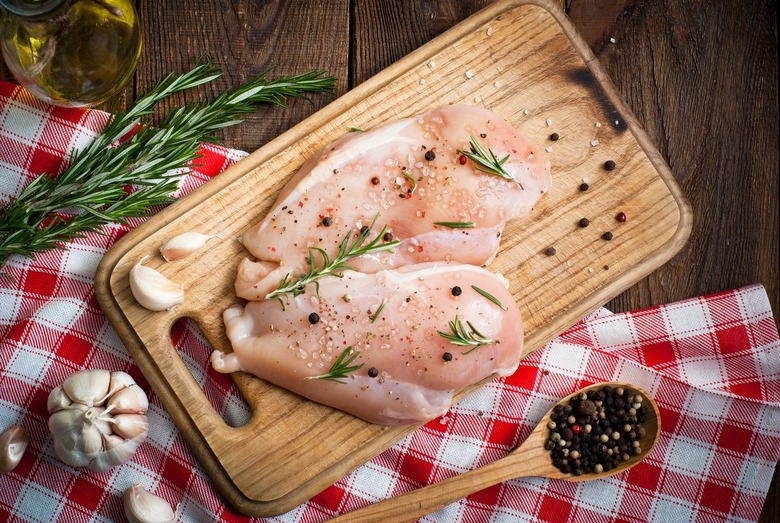The Newest Paleo Diet Needs To Stop It With The Raw Chicken (Because Ugh)
We may receive a commission on purchases made from links.
The latest in paleo diet trends appears to have taken a turn for the worst — all meat, which comprises a majority of the calories consumed by the average paleo person, is to be eaten 100 percent raw.
Okay, you might be thinking, trying to make sense of this absurd news. People eat raw fish all the time. That's probably it.
Nope.
It's not just raw sushi, not just raw eggs, and not just beef tartare. It involves raw chicken, too. And sausage. And lamb. Sometimes, it involves eating ground beef right out of the bag.
Many have become passionate about the diet, holding a strong belief that eating vegetables only when they're cooked and meat only when it's raw "optimizes digestion."
The premise is that cooked meat is difficult for the body to digest, as are raw vegetables, grains, beans, and other processed foods. They believe that humans, as animals, weren't made to digest these foods and that our bodies, like those of dogs and cats, actually prefer to eat all meat completely raw.
With easier digestion, raw paleo diet advocates believe that the nutrients in foods become more bioavailable, resulting in more being absorbed and used by the body. The effects, many testify, are tangible. One advocate of the diet, Melissa Henig, claims, "The thing I've noticed since eating raw paleo is that I'm stronger than I've ever been and have the most muscle definition ever."
As Henig explains in a synopsis of her book Raw Paleo: The Extreme Advantages of Eating Paleo Foods in the Raw, "The raw paleo way of eating helps to remove toxins from your body while simultaneously nourishing your body." The evidence behind her claims is wholly anecdotal — based on her experiences and those of only a few others.
There hasn't been sufficient research on the benefits of eating meat completely raw, but the personal accounts are adding up as more and more health nuts decide to give raw meat a try.
Blogger and health podcast host Christina Rice doesn't eat entirely raw paleo, but has been dabbling in the trend. She recently wrote an extensive blog post on her decision — though she isn't completely raw paleo, she occasionally "indulges" in meals with raw meat.
"When I eat ground lamb," she relays to her readers, "I usually either eat it plain, dolloped on top of my food, or I will mix it in with spices and a bit of fat." In the photo below, she made her meatballs by mixing the meat with basil, oregano, rosemary, and lard.
Once Rice went raw, she couldn't go back: "It's like my body just wants it. NEEDS it. It's something I crave all the time now," she confessed.
Though she claims the desire feels primal, her reasons for eating raw meat in the first place stemmed from her own research. "I slowly came to understand that mainstream society has it backwards in terms of how to cook our food for optimal digestion," she explains. "When we cook meat, it actually destroys a lot of the enzymes found naturally in that meat that help with the digestion process."
The raw paleo diet advocate fails to cite any research to support these claims and the science actually suggests the opposite. As Adriana Heguy, a professor of pathology at New York University Langone Medical Center, explained in an answer given earlier this year on Quora, these assumptions about how human digestion works are entirely misguided.
"Cooking food in general, not only meats, makes them more digestible and more calories can be extracted from cooked food," explained Heguy. Carnivores, including cats and foxes, have stomachs that evolved to best digest raw meat. Humans, on the other hand, evolved from apes and are therefore considered omnivores. The omnivore's stomach has not evolved in this way.
For omnivores in the wild, raw meat is rarely (if ever) a portion of their diet. "When they eat meat, says Heguy, "they eat it fresh."
The meat we get from the grocery store — or even the farmer's market, where Christina Rice buys her meat — is not fresh.
It's been through freezing, processing, preservation methods, and more, well before it even hits the shelves. And who knows how long it was sitting there before you picked it up?
The chicken you grab from the meat aisle was killed a long, long time ago. Meaning that it was at risk of contamination for a long, long time, too.
When we cook meat, the high heat kills bacteria. But because people on the raw paleo diet go without cooking their packaged, store-bought meat, the bacteria could still be lingering during consumption. The tray of "chicken ceviche" below, for example, was ingested as-is. This puts the consumer at elevated risk for disease.
Ingesting bacteria from raw meat can result in serious illness from malignant bacteria such as E. coli and salmonella, worms, and viruses like hepatitis E. One French boy was even disabled for life from eating frozen beef.
"Packaged ground beef is particularly likely to house sickness-causing bacteria or parasites," says Dr. Lee-Ann Jaykus, a professor of food science at North Carolina State University. A single package of beef could be contaminated from dozens of cows and could come into contact with parts of the animal that aren't safe for consumption, such as the small intestines and feces. There's a reason certain foods have been cut out of the average person's diet for centuries — they could be deadly.
This makes Melissa Henig's consumption of meat directly from the package more than a little concerning.
